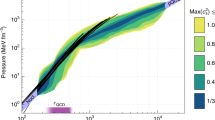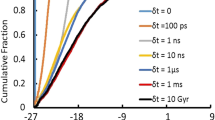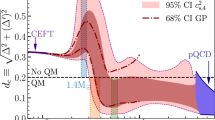Abstract
THE equation of state of matter compressed to supernuclear densities is of considerable interest in astrophysics. For example, pulsars are stars compressed to densities greater than the density of atomic nuclei and are thought to be composed primarily of neutrons, based on detailed calculations of the equation of state of baryonic matter assuming that interaction potentials for the baryons (nucleons and hyperons) are derived from low energy nuclear physics1. There is, however, considerable evidence from high energy physics that baryons have structure, and it is currently believed that this structure is due to the fact that all hadrons consist of quarks bound by vector gluons2. The fact that free, isolated quarks have not been observed has led to the speculation that quarks may be permanently bound inside hadrons3. Since the quarks inside the nucleon behave as free particles2, the forces confining the quarks apparently become strong only when the distance between quarks exceeds the radius of a nucleon, ∼ 10−13 cm. When the density of matter is increased beyond the point that the mean distance between quarks in different baryons is ≪ 10−13 cm the description of matter as interacting baryons becomes invalid, and instead, a description of matter composed of quarks becomes relevant. At sufficiently high densities matter will behave like a relativistic gas of free quarks4 with P ≃ ρ/3, where P is the pressure and ρ is the energy density of matter. The density at which the baryon to quark transition occurs is of crucial importance to the structure of pulsars. General relativity implies that for a given equation of state there is a maximum energy density for stable stars1. It is therefore of considerable interest to know whether the energy density of baryon matter at the baryon–quark phase transition is less than this maximum value. Indeed, it has recently been suggested5 that the existence of quark matter inside pulsars would allow larger masses for pulsars than was previously thought possible. We will show, however, that there are reasons to doubt this.
This is a preview of subscription content, access via your institution
Access options
Subscribe to this journal
Receive 51 print issues and online access
$199.00 per year
only $3.90 per issue
Buy this article
- Purchase on Springer Link
- Instant access to full article PDF
Prices may be subject to local taxes which are calculated during checkout
Similar content being viewed by others
References
Baym, G., and Pethick, C. J., A. Rev. nucl. Sci., 25, 27 (1975).
Gilman, F. J., in Proc. XVIII Int. Conf. High Energy Phys., London, July, 1974.
Drell, S. D., Lectures at Ettore Majorana International Summer School, Erice Sicily, 1975, (in the press).
Collins, J. C., and Perry, M. J., Phys. Rev. Lett., 34, 1353 (1975).
Brecher, K., and Caporaso, G., Nature, 259, 377 (1976).
Chodos, A., Jaffe, R. L., Johnson, K., Thorn, C. B., and Weisskopf, V. F., Phys. Rev., D., 9, 3471 (1974).
DeGrand, T., Jaffe, R. L., Johnson, K., and Kiskis, J., Phys. Rev., D12, 2060 (1975).
Bethe, H. A., and Johnson, M. B., Nucl. Phys., A230, 1 (1974).
Pandharipande, V. R., and Smith, R. A., Nucl. Phys., A237, 507 (1975).
Malone, R. C., Johnson, M. B., and Bethe, H. A., Astrophys. J., 199, 741 (1975).
Nauenberg, M., and Chapline, G., Astrophys. J., 179, 277 (1973).
Author information
Authors and Affiliations
Rights and permissions
About this article
Cite this article
CHAPLINE, G., NAUENBERG, M. Phase transition from baryon to quark matter. Nature 264, 235–236 (1976). https://doi.org/10.1038/264235a0
Received:
Accepted:
Issue Date:
DOI: https://doi.org/10.1038/264235a0
This article is cited by
-
Limiting angular velocity of realistic relativistic neutron star models
Zeitschrift f�r Physik A Hadrons and Nuclei (1991)
-
Quark core stars, quark stars and strange stars
Zeitschrift f�r Physik C Particles and Fields (1989)
-
Hadron-quark phase transition in dense stars
Zeitschrift für Physik C Particles and Fields (1988)
-
Confinement and phase transitions
Zeitschrift f�r Physik C Particles and Fields (1981)
Comments
By submitting a comment you agree to abide by our Terms and Community Guidelines. If you find something abusive or that does not comply with our terms or guidelines please flag it as inappropriate.



